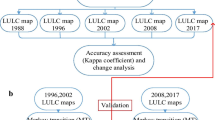Abstract
The UAE has witnessed rapid urban development and economic growth in recent years. With its ambitious vision to become one of the advanced nations by 2021, planners and policy-makers need to know the most likely direction of future urban development. In this study, remotely sensed imagery coupled with cellular automata models were used to predict land cover in Al Ain, the second largest city in the Emirate of Abu Dhabi. Markov and cellular automata models were used for 1992 and 2006 to predict land cover in 2012. Land Use and Land Cover maps for the study area were derived from 1992, 2006, and 2012 Landsat satellite images (TM, ETM+). The models achieved an overall accuracy of approximately 80 %. A Markov model was applied for 2006 and 2012 to predict land cover in 2030. The results conformed to the general trend of the Al Ain Master Plan 2030. This study demonstrates that remote sensing, with the availability of free Landsat data, is a viable technology that could be used to help in the prediction process especially in developing countries, where data availability is a problem.


Similar content being viewed by others
References
Araya, Y. H., & Cabral, P. (2010). Analysis and modeling of urban land cover change in Setúbal and Sesimbra, Portugal. Remote Sensing, 2(6), 1549–1563.
Clarke, K. C., Hoppen, S., & Gaydos, L. (1997). A self-modifying cellular automaton model of historical urbanization in the San Francisco bay area. Environment and Planning B: Planning and Design, 24, 247–261.
Eastman, J. R. (2012). Change Analysis. In IDRISI Selva Manua (pp. 227–229). Worcester: Clark University.
Guan, D., Li, H., Inohae, T., Su, W., Nagaie, T., & Hokao, K. (2011). Modeling urban land use change by the integration of cellular automaton and Markov model. Ecological Modelling, 222(20–22), 3761–3772.
Houet, T., & Hurbert-Moy, L. (2006). Modelling and projecting land-use and land-cover changes with a Cellular Automaton in considering landscape trajectories: an improvement for simulation of plausible future states. EARSeL eProceedings, 5, 63–76. European Association of Remote Sensing Laboratories.
Issa, S. M., & Al Shuwaihi, A. (2011). Analysis of LULC Changes and Urban Expansion of the Resort City of Al Ain Using Remote Sensing and GIS. 6th International Workshop on the Analysis of Multi-temporal Remote Sensing Images (Multi-Temp), (pp. 245–248). Trento.
Jensen, J. R. (1996). Introductory Digital Image Processing. A Remote Sensing Perspective (2nd ed.). Upper Saddle River, New Jersy, United States of America: Prentice Hall.
Lee, Y., & Chang, H. (2011). The simulation of land use change by using CA-Markov model: A case study of Tainan City, Taiwan. 19th International Conference on Geoinformatics, (pp. 1–4).
Longley, P. A., Goodchild, M. F., Maguire, D. J., & Rhind, D. W. (2010). Geographic Information Systems and Science (3rd ed.). New York: John Wiley and Sons, Inc.
Mahajan, S., & Panwar, P. (2005). Land use change in Ashwani Khad watershed using GIS technologies. Journal of the Indian Society of Remote Sensing, 33 (2), 413–420.227–232.
Nayak, S. R., & Chauhan, H. B. (2005). Land Use/Land Cover changes near Hazir region, Gujarat using remote sensing satellite data. Journal of the Indian Society of Remote Sensing, 33(3), 413–420.
Plan Al Ain 2030. (2009). Abu Dhabi, United Arab Emirates: Abu Dhabi Urban Planning Council.
Sang, L., Zhang, C., Yang, J., Zhu, D., & Yun, W. (2011). Simulation of land use spatial pattern of towns and villages based on CA–Markov model. Mathematical and Computer Modelling, 54(3-4), 938–943.
Shair, I. M., & Nasr, A. H. (1999). Using satellite images to detect land-use change in Al-Ain City, United Arab Emirates. The Arabic World Geographer, 2(2), 139–148.
Silva, E. A., & Clarke, K. C. (2005). Complexity, Emergence and Cellular Urban Models: Lessons Learned from Applying Sleuth to Two Portuguese Metropolitan Areas. European Planning Studies, 13.
Statistical Yearbook of Abu Dhabi 2011. (2011). Abu Dhabi, United Arab Emirates: Statistics Centre - Abu Dhabi.
Wang, Y., & Zhang, X. (2001). A dynamic modeling approach to simulating socioeconomic effects on landscape changes. Ecological Modelling, 140, 141–162.
Yagoub, M. M. (2004). Monitoring of urban growth of a desert city through remote sensing: Al-Ain, UAE, between 1976 and 2000. International Journal of Remote Sensing, 25(6), 1063–1076.
Acknowledgments
Thanks are due to Dr. Nazmi Saleous and Mr. Ahmad Nassar for their valuable support and assistance. Gratitude is extended to Dr. Gerald George Garland and Professor Ian MacLachlan for their efforts in editing the paper. The Editor of the Journal of the Indian Society of Remote Sensing and the anonymous reviewers are acknowledged for their constructive suggestions and comments.
Author information
Authors and Affiliations
Corresponding author
About this article
Cite this article
Yagoub, M.M., Al Bizreh, A.A. Prediction of Land Cover Change Using Markov and Cellular Automata Models: Case of Al-Ain, UAE, 1992-2030. J Indian Soc Remote Sens 42, 665–671 (2014). https://doi.org/10.1007/s12524-013-0353-5
Received:
Accepted:
Published:
Issue Date:
DOI: https://doi.org/10.1007/s12524-013-0353-5




